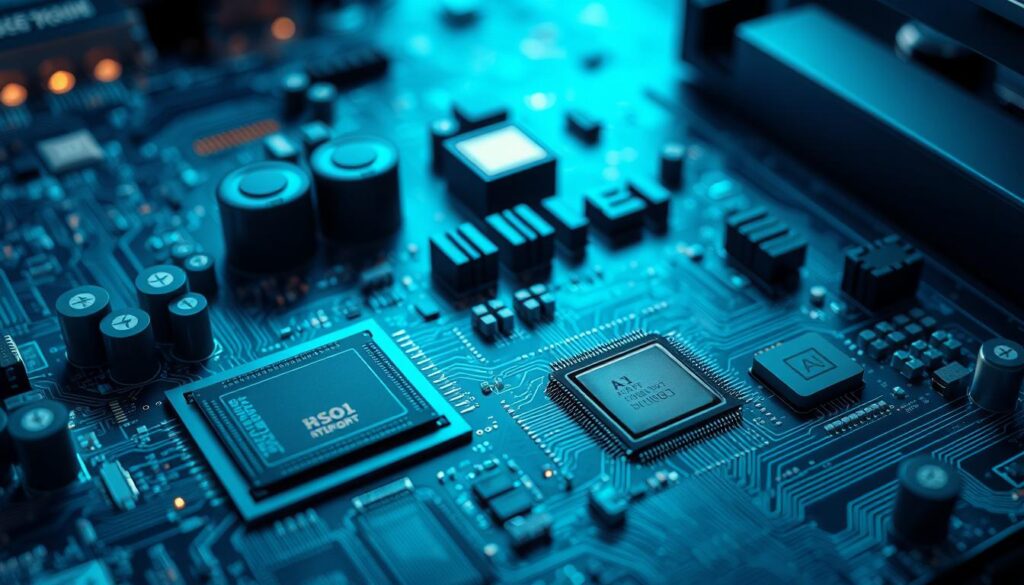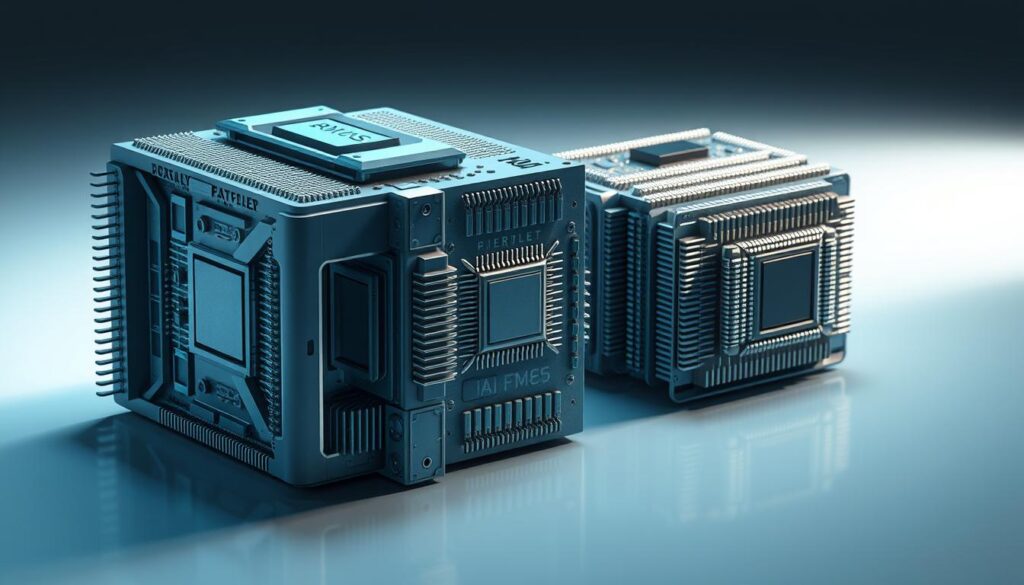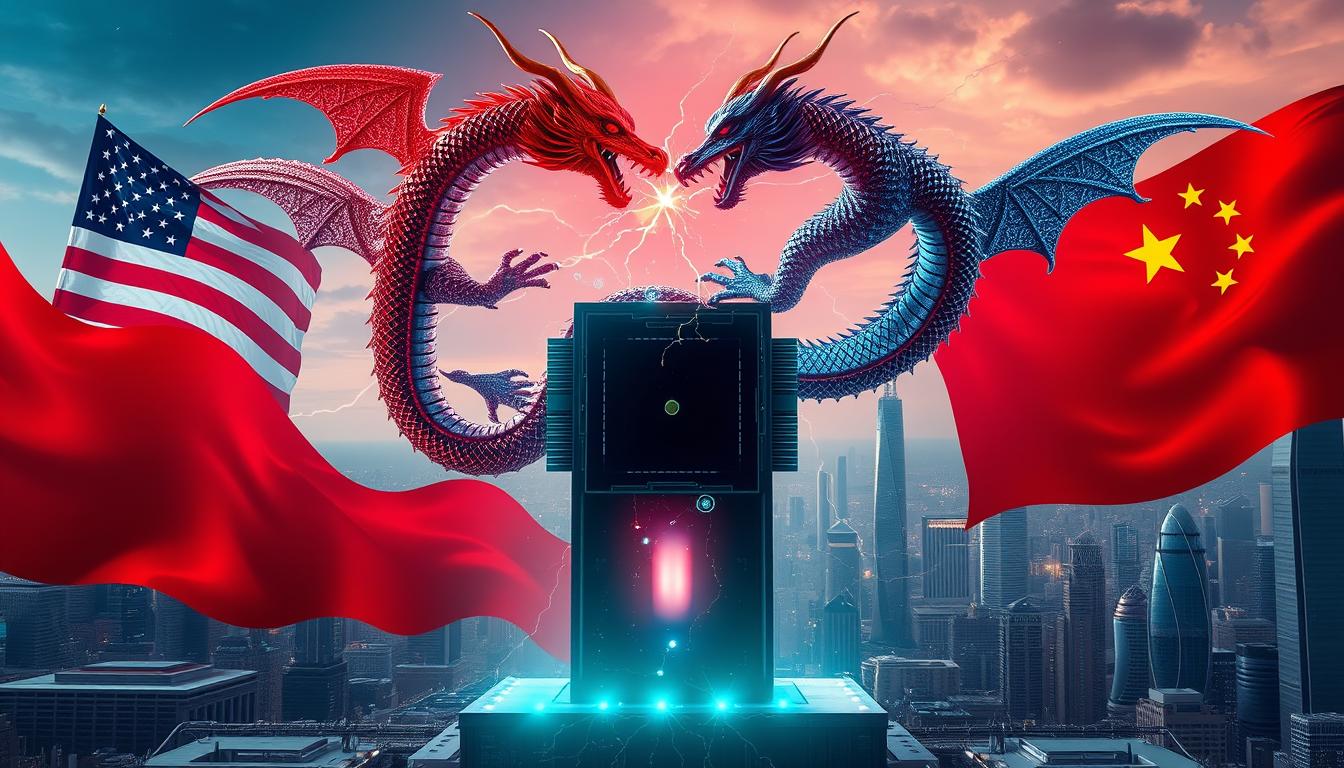The US and China are engaged in a fierce competition to dominate the AI landscape, with AI chip technology playing a pivotal role. Recent advancements by Chinese companies like DeepSeek have challenged the US lead in AI, underscoring the importance of algorithmic efficiency and cost-effectiveness.
The semiconductor industry is at the forefront of this competition, driving innovations that are crucial for AI development. As the US-China AI race intensifies, the focus on AI chip technology is expected to grow, with significant implications for the global tech landscape.
Key Takeaways
- The US-China AI race is driven by advancements in AI chip technology.
- Chinese companies like DeepSeek are challenging the US lead in AI.
- Algorithmic efficiency and cost-effectiveness are critical in the AI race.
- The semiconductor industry plays a vital role in AI development.
- Innovations in AI chip technology will have significant global implications.
The Strategic Importance of Advanced Semiconductors
The strategic importance of advanced semiconductors cannot be overstated in today’s tech-driven world. These cutting-edge components are the foundation upon which modern computing is built, enabling faster processing, improved memory, and increased storage capabilities.
Foundation of Modern Computing Power
Advanced semiconductors play a crucial role in delivering the computing power required for demanding applications such as AI workloads. The processing requirements for these workloads are particularly stringent, necessitating high-performance processors capable of handling complex calculations.
Processing Requirements for AI Workloads
AI and machine learning applications require specialized processing units that can handle parallel processing and high-speed data transfer. Advanced semiconductors are designed to meet these needs, providing the necessary computing power to drive AI innovation.
Memory and Storage Considerations
In addition to processing power, advanced semiconductors also impact memory and storage. High-speed memory technologies such as HBM (High-Bandwidth Memory) are crucial for AI applications, providing the necessary bandwidth for data-intensive operations.
Economic Impact of Semiconductor Leadership
Achieving semiconductor leadership has significant economic implications. Companies that dominate the semiconductor market can drive innovation, influence industry standards, and reap substantial financial rewards.
| Aspect | Impact of Semiconductor Leadership | Economic Benefit |
|---|---|---|
| Innovation | Drives technological advancements | Increased competitiveness |
| Industry Standards | Influences global tech standards | Market dominance |
| Financial Rewards | Substantial revenue generation | Economic growth |
Why This Key Chip Technology Is Crucial to the AI Race Between the US and China
Chip technology plays a pivotal role in the ongoing AI race between the US and China. The development and deployment of advanced AI models rely heavily on the capabilities of semiconductor technology.
AI Model Training Dependencies
AI model training is a computationally intensive process that requires significant semiconductor resources. Large language models need vast amounts of computational power to process and analyze enormous datasets.
Computational Requirements for Large Language Models
The training of large language models demands high-performance computing infrastructure, including advanced GPUs and specialized AI accelerators. These components are crucial for reducing training times and improving model accuracy.
Inference Speed and Efficiency Challenges
Inference speed is another critical factor in AI model deployment. Efficient inference requires optimized hardware and software solutions to minimize latency and maximize throughput.
National Competitiveness Implications
The implications of leadership in AI development extend beyond technological advancements to national competitiveness. Countries that lead in AI technology are likely to have significant economic and strategic advantages.
First-Mover Advantages in AI Development
Being the first to develop and deploy advanced AI technologies can provide a nation with first-mover advantages, including economic benefits, improved national security, and enhanced global influence.

The Evolution of Semiconductor Manufacturing
As the demand for more powerful and efficient chips grows, the semiconductor manufacturing landscape is evolving rapidly. This evolution is driven by the need to overcome the limitations of current technology and to push the boundaries of what is possible in chip design and production.
Moore’s Law and Its Current Limitations
Moore’s Law, which states that the number of transistors on a microchip doubles approximately every two years, has been the driving force behind the advancement of semiconductor technology. However, as transistors approach the size of individual atoms, it becomes increasingly challenging to continue this trend.
Transition to Sub-7nm Processes
The transition to sub-7nm processes has been a significant step in overcoming the limitations of Moore’s Law. This transition has been made possible by breakthroughs in EUV lithography and advancements in materials science.
EUV Lithography Breakthroughs

EUV lithography has emerged as a critical technology in the production of sub-7nm chips, allowing for more precise control over the manufacturing process.
Materials Science Innovations
Innovations in materials science have also played a crucial role in the development of sub-7nm processes. New materials and techniques have been developed to improve the performance and efficiency of chips.
Key Players in the Global Semiconductor Ecosystem
The semiconductor landscape is dominated by key players from the US, China, and other countries. These companies are driving innovation and competition in the industry.
American Technology Leaders
American companies are at the forefront of semiconductor technology. NVIDIA’s GPU dominance in the AI computing space is a significant factor in the US’s competitive edge.
NVIDIA’s GPU Dominance
NVIDIA’s graphics processing units (GPUs) are widely used for AI model training due to their high performance and efficiency. This dominance has enabled NVIDIA to maintain a strong position in the market.
Intel’s Manufacturing Resurgence
Intel is focusing on its manufacturing capabilities, aiming to regain its leadership in semiconductor manufacturing. This resurgence is crucial for the US’s semiconductor industry.
Chinese Emerging Competitors
Chinese companies are emerging as significant players in the semiconductor ecosystem. Huawei HiSilicon’s developments in semiconductor design are noteworthy.
Huawei HiSilicon Developments
Huawei HiSilicon has made significant advancements in designing high-performance semiconductors for various applications, including AI.
Emerging Startups and State-Backed Entities
China is also seeing the emergence of startups and state-backed entities in the semiconductor space, further diversifying its semiconductor capabilities.
The Critical Role of TSMC and Samsung
Companies like TSMC and Samsung play a critical role in the global semiconductor supply chain, providing advanced manufacturing services.
![]()
Their capabilities in producing cutting-edge semiconductors are essential for the development of AI technologies.
Specialized AI Chip Architectures
As AI continues to advance, the importance of specialized chip architectures cannot be overstated. The development of these architectures is crucial for enhancing AI workloads and driving innovation in the field.

GPUs and Their Evolution for AI Workloads
Graphics Processing Units (GPUs) have evolved significantly to handle AI-specific tasks. Originally designed for graphics rendering, GPUs are now pivotal in AI model training due to their parallel processing capabilities.
NVIDIA’s H100 and A100 Capabilities
NVIDIA’s H100 and A100 GPUs are at the forefront of AI computing, offering unprecedented performance for AI workloads. These GPUs are designed to accelerate AI model training and inference, making them indispensable for AI researchers and developers.
AMD’s Competitive Positioning
AMD has been gaining ground in the AI GPU market with its competitive offerings, challenging NVIDIA’s dominance. AMD’s GPUs are designed to provide cost-effective solutions for AI computing, appealing to a broad range of developers.
TPUs and ASICs for Machine Learning
Tensor Processing Units (TPUs) and Application-Specific Integrated Circuits (ASICs) are custom-designed for machine learning tasks, offering significant performance improvements over general-purpose processors.
Google’s TPU Advancements
Google’s TPUs are a prime example of ASICs optimized for machine learning. These TPUs are designed to accelerate TensorFlow computations, providing substantial performance gains for AI workloads.
Custom Silicon for Specific AI Applications
Custom silicon solutions, like ASICs, are being developed for specific AI applications, offering optimized performance and efficiency. These custom chips are tailored to the exact needs of the application, reducing latency and improving throughput.
Neuromorphic and Analog Computing Approaches
Neuromorphic computing, inspired by the human brain, and analog computing approaches are emerging as promising alternatives for AI processing. These architectures aim to revolutionize AI computing by providing more efficient and adaptive processing capabilities.
US Semiconductor Strategy and Policy Framework
The United States has adopted a robust strategy to bolster its semiconductor sector, focusing on both domestic production capabilities and international cooperation. This comprehensive approach is driven by the recognition of semiconductors as a critical component in modern technology and national security.
The CHIPS and Science Act Implementation
The CHIPS and Science Act is a cornerstone of the US semiconductor strategy, providing significant funding and incentives for semiconductor manufacturing and research.
Manufacturing Incentives and Results
The Act offers substantial manufacturing incentives, encouraging companies to establish and expand semiconductor production facilities in the US. These incentives have already begun to yield results, with several major manufacturers announcing new projects.
Research and Development Funding
In addition to manufacturing incentives, the CHIPS and Science Act allocates significant funds for research and development in advanced semiconductor technologies. This investment is expected to drive innovation and maintain US leadership in the field.
Export Control Measures and Their Impact
The US has also implemented export control measures to restrict the flow of sensitive semiconductor technologies to certain countries. These controls aim to protect national security and prevent the proliferation of advanced technologies that could be used against US interests.
![]()
International Alliances and Partnerships
Recognizing the global nature of the semiconductor industry, the US is strengthening international alliances and partnerships to enhance cooperation in semiconductor research, manufacturing, and trade.
Coordination with European and Asian Allies
The US is working closely with European and Asian allies to establish common standards, share best practices, and coordinate policies to ensure a stable and secure global semiconductor supply chain.
| Initiative | Description | Expected Outcome |
|---|---|---|
| CHIPS and Science Act | Funding and incentives for semiconductor manufacturing and research | Enhanced US semiconductor production and innovation |
| Export Controls | Restrictions on the export of sensitive semiconductor technologies | Protection of national security and prevention of technology proliferation |
| International Alliances | Cooperation with European and Asian allies on semiconductor research and trade | Stable and secure global semiconductor supply chain |
China’s Push for Semiconductor Self-Sufficiency
China is embarking on an ambitious journey to achieve semiconductor self-sufficiency, driven by government investment and domestic manufacturing advancements. This strategic initiative is crucial in the ongoing AI race between the US and China, as it aims to reduce reliance on foreign technology and bolster national competitiveness.
Government Investment Programs
The Chinese government has launched several initiatives to support the development of its semiconductor industry. Key among these are the “Made in China 2025” initiative and the National IC Investment Funds.
Made in China 2025 and Beyond
“Made in China 2025” is a state-led industrial policy aimed at upgrading China’s manufacturing capabilities, with a significant focus on semiconductors. This initiative has been instrumental in guiding government investments and subsidies towards the development of domestic semiconductor manufacturing capabilities.
National IC Investment Funds
The National IC Investment Funds have been established to provide financial support to domestic semiconductor companies. These funds have played a critical role in enabling companies like SMIC to advance their manufacturing capabilities.
SMIC and Domestic Manufacturing Progress
SMIC, China’s largest foundry, has made significant strides in advancing domestic semiconductor manufacturing. With the support of government investment programs, SMIC has been able to develop more sophisticated manufacturing processes, narrowing the gap with international leaders.
Alternative Technology Pathways
In addition to investing in traditional semiconductor manufacturing, China is also exploring alternative technology pathways to achieve self-sufficiency. These include architectural innovations and open-source hardware initiatives.
Architectural Innovations to Bypass Restrictions
Chinese companies are developing innovative chip architectures that can bypass export restrictions imposed by other countries. This involves designing chips that are not only competitive in terms of performance but also compliant with domestic needs.
Open-Source Hardware Initiatives
Open-source hardware initiatives are gaining traction in China as a means to accelerate semiconductor development. By leveraging open-source designs, Chinese companies can reduce development costs and accelerate time-to-market for new semiconductor products.
The Technology Gap Assessment
Assessing the technology gap between the US and China is crucial for understanding the AI race dynamics. The current landscape of semiconductor technology is characterized by significant advancements in both countries, yet there remains a notable disparity in their capabilities.
Current Manufacturing Capabilities Comparison
The US currently leads in advanced semiconductor manufacturing, with companies like Intel and TSMC (though TSMC is based in Taiwan, it has significant operations in the US) at the forefront of technology. China, however, is rapidly closing this gap through substantial government investment and initiatives to develop its domestic manufacturing capabilities.
Design Expertise and IP Ownership
In terms of design expertise and IP ownership, the US maintains a strong position, with companies like NVIDIA and Qualcomm leading in AI-specific chip design. China is making strides in this area as well, with companies like Huawei and SMIC gaining ground.
Projected Timeline for Technological Parity
Predicting when China will achieve technological parity with the US is complex. While China has made significant progress, the US continues to innovate, maintaining a delicate balance in the technology gap.
Short-term Workarounds vs. Long-term Solutions
As stated by
“The future of AI is not just about hardware; it’s about the ecosystem that supports it.” – Dr. Andrew Ng
, the focus should be on developing a robust ecosystem that includes both hardware and software advancements. In the short term, workarounds such as leveraging existing technology and strategic partnerships can help bridge the gap. However, long-term solutions will require sustained investment in research and development.
National Security and Economic Implications
The race to develop AI-specific chips is not just about technological advancement; it has substantial national security and economic implications. As these chips become more integral to various sectors, their impact on military applications, critical infrastructure, and economic competitiveness grows.
Military Applications of AI-Specific Chips
AI-specific chips are revolutionizing military capabilities by enabling faster and more sophisticated processing of battlefield data. These chips are crucial for applications such as autonomous vehicles, advanced surveillance systems, and real-time data analysis.
Critical Infrastructure Dependencies
Critical infrastructure, including power grids, financial systems, and transportation networks, increasingly relies on AI-specific chips for efficient operation. The security and reliability of these chips are paramount to maintaining national security and economic stability.
Economic Competitiveness Factors
The economic implications of AI-specific chips are significant, with potential impacts on job creation, workforce development, and the overall innovation ecosystem.
Job Creation and Workforce Development
The development and manufacturing of AI-specific chips require highly skilled workers. As demand for these chips grows, so too will the need for a workforce with expertise in semiconductor design and manufacturing.
Innovation Ecosystem Effects
AI-specific chips are driving innovation across various industries, from healthcare to finance. The ecosystem surrounding these chips, including startups and research institutions, is crucial for continued technological advancement.
Supply Chain Vulnerabilities and Resilience Strategies
The intricate semiconductor supply chain is susceptible to various risks, including geographic concentration and raw material dependencies. As the demand for AI-specific chips continues to grow, understanding these vulnerabilities is crucial for developing effective resilience strategies.
Geographic Concentration Risks
The semiconductor industry is characterized by a high degree of geographic concentration, with certain regions playing a critical role in the production process. Taiwan, in particular, is a key player due to its advanced manufacturing capabilities.
Taiwan’s Central Role and Associated Risks
Taiwan’s prominence in the semiconductor supply chain is largely due to the presence of companies like TSMC, which is a leading foundry for advanced chips. However, this concentration of production in a geopolitically sensitive region poses significant risks, including potential disruptions due to political tensions or natural disasters.
Raw Material and Equipment Dependencies
Beyond geographic concentration, the semiconductor supply chain is also vulnerable to dependencies on specific raw materials and equipment. Critical materials such as rare earth elements and high-purity metals are essential for chip production.
Critical Chokepoints in the Supply Chain
The supply chain for semiconductor manufacturing equipment is another area of vulnerability. Specialized equipment, such as lithography machines, is often supplied by a limited number of companies, creating chokepoints that can be disrupted by various factors, including export controls and trade tensions.
Talent and Knowledge Transfer Dynamics
The semiconductor industry relies heavily on highly skilled talent and the transfer of knowledge across the supply chain. As the industry evolves, the ability to attract, retain, and develop talent will be crucial for maintaining competitiveness and resilience.
By understanding these supply chain vulnerabilities, stakeholders can begin to develop strategies to mitigate risks and enhance resilience. This includes diversifying production, investing in supply chain security, and fostering international cooperation.
Future Technological Battlegrounds
The next generation of technological advancements will be driven by innovations in quantum computing, advanced packaging, and sustainable computing. These emerging technologies are set to redefine the semiconductor landscape, playing a crucial role in the ongoing AI race between the US and China.
Quantum Computing Research and Development
Quantum computing represents a significant leap forward in processing power, with potential applications in AI, cryptography, and complex problem-solving. Recent milestones in quantum supremacy have demonstrated the capabilities of quantum computing.
Quantum Supremacy Milestones
- Google’s Sycamore processor achieved quantum supremacy in 2019.
- IBM’s Eagle processor demonstrated quantum advantage in complex calculations.
Quantum-Resistant Cryptography
As quantum computing advances, there is a growing need for quantum-resistant cryptography to secure sensitive information. Researchers are developing new cryptographic protocols to address this challenge.
Advanced Packaging and Chiplet Technologies
Advanced packaging and chiplet technologies are critical for improving semiconductor performance and efficiency. These innovations enable the creation of more complex and powerful chips.
Energy Efficiency and Sustainable Computing
The growing demand for computing power has significant environmental implications. Sustainable computing practices, such as reducing carbon footprint and water usage, are becoming increasingly important.
Carbon Footprint Considerations
The semiconductor industry is exploring ways to reduce its carbon footprint, including the use of renewable energy sources and more efficient manufacturing processes.
Water Usage and Environmental Impacts
Water conservation is another critical aspect of sustainable computing. Companies are implementing measures to reduce water usage in their manufacturing processes.
Conclusion: Navigating the Future of the Semiconductor Race
The US-China AI race is driving innovation in the semiconductor industry, with significant implications for the future of AI. As the competition between the US and China intensifies, understanding the current landscape and emerging trends is crucial to navigating the future of the semiconductor race.
The semiconductor race is not just about technological advancements; it’s also about national competitiveness and economic leadership. The future of AI depends on the development of specialized chip architectures, and the US and China are investing heavily in this area.
To stay ahead in the semiconductor race, continued innovation and investment in emerging technologies are essential. As the industry moves forward, companies and governments must work together to address supply chain vulnerabilities and develop strategies for sustainable computing.
FAQ
What is driving the US-China AI race?
The US-China AI race is driven by the development of advanced semiconductor technologies, particularly chip technology, which is crucial for AI model training and deployment.
Why are advanced semiconductors important for AI?
Advanced semiconductors provide the necessary computing power, memory, and storage for AI workloads, enabling faster and more efficient processing of complex AI models.
What is the significance of Moore’s Law in semiconductor manufacturing?
Moore’s Law has driven the advancement of semiconductor manufacturing, but its limitations have led to the development of new technologies, such as EUV lithography and sub-7nm processes.
Who are the key players in the global semiconductor ecosystem?
Key players include American technology leaders like NVIDIA and Intel, Chinese emerging competitors, and critical manufacturers like TSMC and Samsung.
What is the role of specialized AI chip architectures?
Specialized AI chip architectures, such as GPUs, TPUs, and ASICs, are designed to optimize AI workloads, providing improved performance, efficiency, and scalability.
What is the US semiconductor strategy and policy framework?
The US semiconductor strategy includes the CHIPS and Science Act, export control measures, and international alliances to promote domestic manufacturing, research, and development.
How is China pushing for semiconductor self-sufficiency?
China is investing heavily in government programs, domestic manufacturing, and alternative technology pathways to reduce its dependence on foreign semiconductor technology.
What is the current technology gap between the US and China?
The technology gap is assessed by comparing current manufacturing capabilities, design expertise, and IP ownership, with the US currently leading in many areas.
What are the national security implications of AI-specific chips?
AI-specific chips have significant national security implications, including military applications, critical infrastructure dependencies, and economic competitiveness factors.
What are the supply chain vulnerabilities in the semiconductor industry?
Supply chain vulnerabilities include geographic concentration risks, raw material dependencies, and talent and knowledge transfer dynamics, particularly with regards to Taiwan’s central role.
What are the future technological battlegrounds in the semiconductor industry?
Future technological battlegrounds include quantum computing research and development, advanced packaging and chiplet technologies, and energy efficiency and sustainable computing.
What is the impact of chip technology on the AI race between the US and China?
Chip technology is crucial to the AI race, as it enables faster, more efficient, and more scalable AI processing, driving national competitiveness and economic implications.


